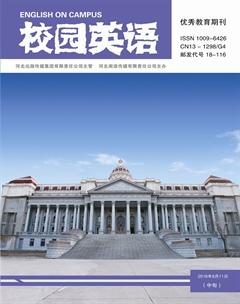Cohesive Devices in Legal English Translation
邹丹
1. Introduction
It was Halliday & Hasan who made “cohesion” a linguistic term to describe such linguistic phenomena as reference, substitution, ellipsis, conjunction, synonymy and other cohesive devices. Halliday divided cohesion into grammatical cohesion and lexical cohesion in 1964, and Hasan, elaborated on grammatical cohesion in 1968 before they published cohesion in English in 1976.
In this thesis, the author will introduce three cohesive devices to analyze the text of Agreement on TRIPS. Besides, the author will talk about the translation version concerning the cohesive devices in TRIPS so as to facilitate legal English study and translation practice.
2. Cohesive Devices
As mentioned above, cohesive devices is the way to realize cohesion. And there are two ways of creating cohesion in a text: grammatical cohesion and lexical cohesion. The former refers to reiteration and collocation and the latter consists of reference, ellipsis, substitution and conjunction. Therefore, it can be said that cohesion is the way to get the simple sentences connected not only in form but also in meaning.
3. Application of Cohesive Devices in TRIPS
The following part will mainly center on the use of such three kinds of cohesive devices as conjunction, reference and lexical cohesion in TRIPS.
Lexical Cohesion in TRIPS and Its Translation
Here is an example excerpted from TRIPS to illustrate synonym as a cohesive device in TRIPS.
(1)Each member shall ensure ... do not unreasonably impair the opportunity ...
(2)Members may provide... do not unreasonably prejudice the legitimate interests ... (Section 4 Industrial Design)
每个成员应确保...不会不合理地损害...机会。
各成员可以...不会不合理地妨害...合法利益。
In these two sentences, “impair” and “prejudice” are two synonyms which mean “to damage or to do harm to”. Such employment of synonyms is one way to meet the requirement of cohesion. Also, in the translated version, “损害”and“妨害”are used,which in Chinese are synonyms, too. And compared with repetition, this kind of lexical cohesion is acceptable with the same effect.
Reference in TRIPS and its Translation
Look at the following example which gives an explanation of reference.
(3)Members shall give effect to the provisions of this Agreement... ( Article 1 Nature and Scope of Obligation)
各成员应使本协定的各项规定生效。(第1条 责任的性质和范围)
It can be seen that the underlined phrase “this Agreement” is used as the lexical cohesive device called repetition. From the translation angle, it can be seen that in Chinese the phrase “本协定” is also used repeatedly the same way as it is in its English version. Therefore, this shows the similarity of cohesive devices in both Chinese and English discourse.
Conjunction in TRIPS and its Translation
However, as mentioned before, sometimes the cohesive devices may not be translated as they only work as functional words. See example below:
(4)The owner of a registered trademark shall have the exclusive right to ... for goods or services which are identical ... (Article 16 Rights Conferred)
注册商标的所有人应有专有权...对...或服务相同或类似的货物或服务使用相同或类似的标记...(第16条 授予的权利)
The cohesive device used in the sentence is conjunction. Since the conjunctive word “which” is used to demonstrate the subordinating relationship between the clauses. The translated version, compared with the original one, does not give meaning to the underlined word “which”. But it does connects the sentences.
4. Conclusion
To sum up, cohesive devices play an important role in both English and Chinese text, and some common grounds of cohesive devices are shared in both languages. From the analysis, it is hoped that legal English can be better understood and translated from the perspective of cohesion. However, due to the limited knowledge and materials at hand, the analysis is made at a superficial level. Further effort is still need for deep study of it.
References:
[1]Halliday,M.A.K.& Hasan,R.Cohesion in English[M].London:Longman,1976.
[2]刘润清,文旭.新编语言学教程[M].外语教学与研究出版社,2006.
[3]肖云枢,王建,谯莉,余素青.法律英语高级教程[M].中国人民大学出版社,2011.
[4]曾文华.英汉语篇衔接手段的差异与翻译策略[D].华中师范大学,2004.

